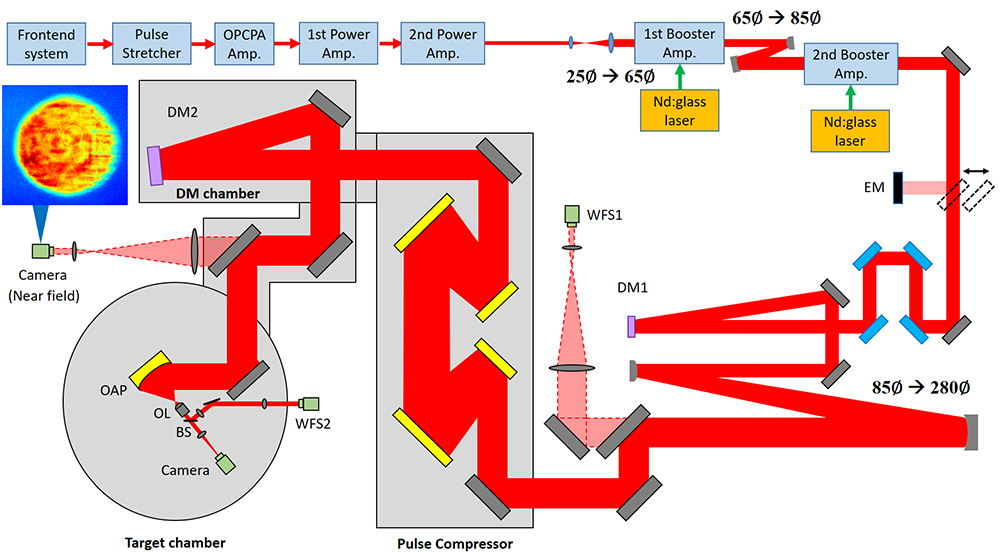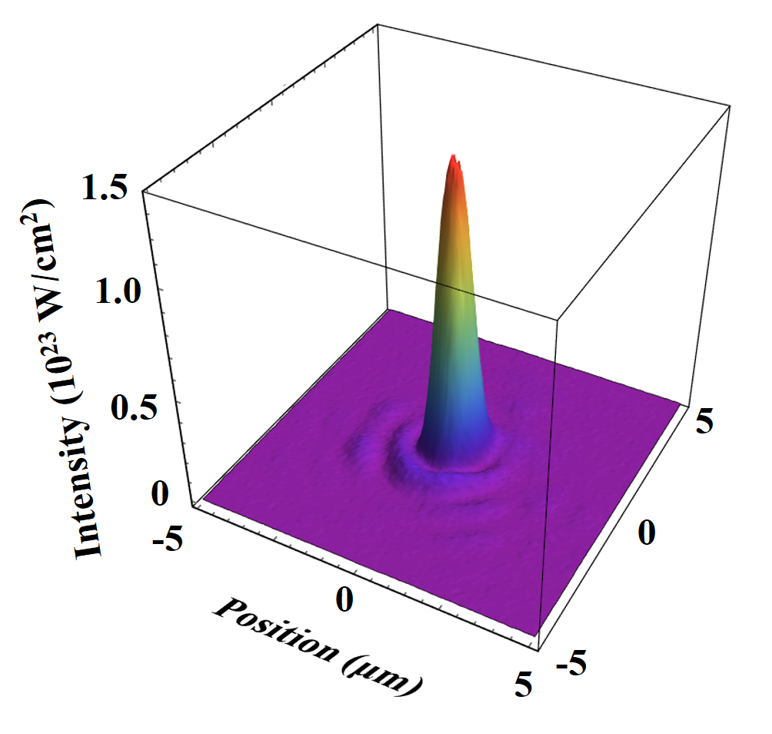From Institute for Basic Science [ 기초과학연구원](KR)
The record-breaking laser intensity over 10^23 W/cm^2 enables us to explore novel physical phenomena occurring under extreme physical conditions –

▲ Figure 1. Layout of the CoReLS petawatt laser and the experimental setup to achieve the laser intensity of over 10^23W/cm^2. BS, beam splitter; DM1-2, deformable mirrors; EM, energy meter; OAP, f /1.1 off-axis parabolic mirror; OL, objective lens; WFS1-2, wavefront sensors.

▲ Figure 2. Panoramic view of the CoReLS PW laser.

▲ Figure 3. Measured 3-D focal spot image showing the laser intensity of 1.4×10^23 W/cm^2.
Recently, laser scientists at the Center for Relativistic Laser Science (CoReLS) within the Institute for Basic Science (IBS) in South Korea realized the unprecedented laser intensity of 10^23 W/cm^2. This has been a milestone that has been pursued for almost two decades by many laser institutes around the world.
An ultrahigh intensity laser is an important research tool in several fields of science, including those which explore novel physical phenomena occurring under extreme physical conditions. Since the demonstration of the 10^22 W/cm^2 intensity laser by a team at the University of Michigan (US) in 2004, the realization of laser intensity over 10^23 W/cm^2 has been pursued for nearly 20 years.
In general, achieving such a level of ultra-high laser intensity requires two things: laser with extremely high power output, and focusing that laser to the smallest spot as possible. While continuous-wave lasers are limited to megawatt-scale intensity, far higher peak power output (on the order of petawatt) is possible in pulsed laser systems by delivering the energy in the time scale as short as femtoseconds. In order to reach the goal of developing the world’s most powerful laser, several ultrahigh power laser facilities with outputs of 10 PW and beyond, such as ELI (EU), Apollon (France), EP-OPAL (USA), and SEL (China), have been built or are being planned. A recent study from Osaka University (JP) even proposed a concept prototype for an exawatt class laser.
Meanwhile, the CoReLS laser team has been operating a 4-PW laser system since 2016. This year in April 2021, they have finally achieved the record-breaking milestone of 10^23 W/cm^2 by tightly focusing the multi-PW laser beam.
Several special techniques have been employed to achieve this feat. The power intensity was maximized by using a focusing optics called an off-axis parabolic mirror, which was used to focus a 28 cm laser beam down to a spot only 1.1 micrometers wide. Such a diffraction-limited tight focusing can be obtained only with a clean laser beam without wavefront distortion. The CoReLS laser team, thus, made its PW laser beam as clean as possible using a set of deformable mirrors to correct the wavefront distortion of the PW laser.
The CoReLS 4-PW laser is a femtosecond, ultrahigh power Ti:sapphire laser, based on the chirped pulse amplification (CPA) technique. The layout of the CoReLS 4-PW laser, including the experimental setup to control the wavefront and to measure the intensity, is given in Fig. 1. A low-energy femtosecond laser pulse from the front-end was stretched to a nanosecond pulse by the pulse stretcher. The initial laser pulse was then amplified to 4.5 J by the two power amplifiers and then up to 112 J by the two booster amplifiers. The size of the laser beam increased along the beam path by a series of beam expanders; 25 mm right after the power amplifiers, 65 mm at the entrance of the 1st booster amplifier, 85 mm at the entrance of the 2nd booster amplifier, and 280 mm at the entrance of the pulse compressor. In the pulse compressor, the laser pulse was recompressed to 20 fs (FWHM), which caused its peak power to become 4 PW after the compression.
In order to compensate for the wavefront distortion of the PW laser beam, two deformable mirrors were employed in the PW laser beamline. The first deformable mirror (DM1) with a diameter of 100 mm was installed after the final booster amplifier, with its role being to correct the wavefront distortion accumulated from the front end to the final beam expander. The second deformable mirror (DM2) with a diameter of 310 mm was installed after the pulse compressor, which corrects the additional aberrations induced from large aperture optics in the pulse compressor, the beam delivery line, and the target area. In the target chamber, the PW laser beam was tightly focused with an f /1.1 off-axis parabolic mirror, which possessed an effective focal length of 300 mm. For imaging and characterization of the focused spot, the focused beam was collimated by an objective lens. It was then divided into two beams with a beam splitter for the focal spot and wavefront characterization. A camera was used for the focal spot monitoring of the transmitted laser beam, and a wavefront sensor was used to measure the wavefront of the reflected laser beam. Figure 3 shows the 3-D focal spot image measured by the camera in the target chamber.
Prof. NAM Chang Hee, the Director of CoReLS, notes, “This work has shown that the CoReLS PW laser is the most powerful laser in the world. With the highest laser intensity achieved ever, we can tackle new challenging areas of experimental science, especially strong field quantum electrodynamics (QED) that has been dealt with mainly by theoreticians. We can explore new physical problems of electron-photon scattering (Compton scattering) and photon-photon scattering (Breit-Wheeler process) in the nonlinear regime. This kind of research is directly related to various astrophysical phenomena occurring in the universe and can help us to further expand our knowledge horizon.”
Science paper:
Optica
See the full article here .
five-ways-keep-your-child-safe-school-shootings
Please help promote STEM in your local schools.
Making Discoveries for Humanity & Society
Institute for Basic Science [ 기초과학연구원](KR) pursues excellence in basic science research. The goal of IBS is to advance the frontiers of knowledge and to train the leading scientists of tomorrow.
Accelerate Transformation through New Knowledge
Institute for Basic Science [ 기초과학연구원](KR) was established in November 2011 as Korea’s first dedicated basic science research institute. By studying the fundamental principles of nature, basic science is essential in creating new knowledge from which significant societal transformations are derived. IBS promotes the highest quality of research that will increase the national basic science capacity and generate new opportunities for this nation.
IBS specializes in long-term projects that require large groups of researchers. As research in the 21st century requires more interdisciplinary collaborations from larger groups of people, scientists at IBS work together in the same laboratory base with a long-term perspective on research. We promote autonomy in research. IBS believes scientists unleash their creative potential most effectively when they conduct research in an autonomous environment with world-class research infrastructure, including RISP, the rare isotope accelerator, to enable major scientific advances. By developing strong synergies from outstanding talents, autonomous research support systems, and world-class infrastructure, IBS is steadily growing into a major basic research institute that meets the global standards of excellence.
Ensure Excellence in Research
By pursuing excellence in research, IBS has selected global leading scientists as directors of Centers. These directors are operating 31 Centers of which research proposals are evaluated superior in the IBS peer review process. The review is carried out by a Review Panel composed of independent and expert scientists from Korea and abroad. Directors choose the themes of their research and allocate funds accordingly. Generally, Centers operate projects with no fixed term for their duration as long as the quality of research is verified in evaluations. New Centers receive an initial evaluation five years after its launch, followed by three-year interval evaluations.
IBS has been inviting top scientists from around the globe and providing them full support for their relocations. Young scientists also enjoy unique research opportunities to collaborate with world renowned scientists and to organize and operate their own research groups, broadening their professional expertise. IBS brings together outstanding talents throughout all career levels to grow and inspire each other through close collaborations.
Stimulate Collaboration Without Boundaries
IBS welcomes scientists from Korea and abroad seeking to work in a collaborative research environment. IBS’ faculty researcher program and IBS’s affiliation with the founding body of University of Science & Technology [과학 기술 연합 대학원대학교] (KR) help IBS scientists to reach out to and foster young talent outside the institution. Centers serve as a catalyst for research collaboration with universities and other government-funded research institutions through joint research and the sharing of research equipment. Other efforts are also underway to stimulate collaborations, including overseas training programs and visiting scientist programs.
To disseminate research findings, IBS holds “IBS Conferences” and develops a global network with the world’s prominent research institutions including the MPG Society for the Advancement of Science [MPG Gesellschaft zur Förderung der Wissenschaften e. V.] (DE) and the Royal Society (UK). We expect our work to make transformative changes outside as well as inside the institution. To realize this exciting vision, IBS will serve as a national R&D platform and accelerate the creation and use of new knowledge to support universities, research institutions, and businesses. As a driving force for dynamic research collaborations, IBS will continually develop and refresh its science, while always remaining receptive to outside talents and ideas.
Continue its Endeavor to Make a Brighter Future
IBS shares the same passion as other great minds to investigate the origin of the universe, nature, and life for the development of humanity, as shown in its vision Masking Discoveries for Humanity & Society. We are committed to realizing this vision through a phased endeavor as outlined in our Five-year Plan (2013 – 2017). We aim to:
Become a national hub for basic science research by 2017
Complete the construction of the rare isotope accelerator by 2021
Evolve into one of the world’s top 20 basic research institution by 2030 (measured in terms of impact on research).
Serving as a stimulus for the innovation, IBS HQ will evolve into an urban science park that will promote public outreach and community engagement. Our commitment to enhance the quality of life and make sustainable progress continues every day.


